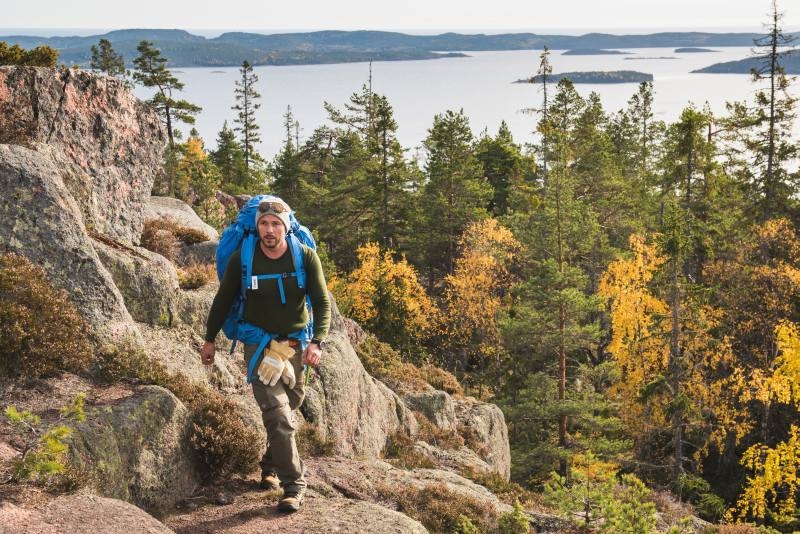- Details
- Written by: Daniel Wildey author
The inside of the tent begins to glow with the rising sun and I wake from a heavy, dreamless sleep - the kind that is elusive on the first night of camping, but by the second night is blissful. Despite the early hour and the temperature outside, I poke my groggy head through the flaps to a glorious sight. I'm camped by the shores of the Gulf of Bothnia, north of the Baltic and on the Swedish Hoga Kusten (or High Coast). The silver birch amongst the spruce and pine that line the beaches are shining golden in the pre-dawn light of autumn.
It's enough to spur me out of my cosy sleeping bag, knowing that the warmth of the sun is only minutes away. The sight of our quiet camp brings a contented smile to my face; hiking boots in tent porches, ash piled in the fire pit, and a fleet of sea kayaks pulled high out of the water all speak of the perfect adventure we've enjoyed so far.
The sun breaches the horizon beyond the mouth of the deserted inlet, and the whole scene takes on the magic it deserves, promising more adventure to come.
I'd arrived two days earlier at Friluftsbyn - a lovely example of the sing-song lilt of the Swedish language, meaning 'outdoor village' - to join the Outdoor Academy of Scandinavia. The OAS is substantially less academic than it sounds; an opportunity for the industry to field test equipment from Scandinavian brands on their home turf. A marketing event it may be, but it speaks volumes about the Scandinavian approach to the outdoors. Whereas many PR events are held in the hip hotels of Shoreditch, it seems unquestionable that the Swedish wilderness be part of the plan for OAS.
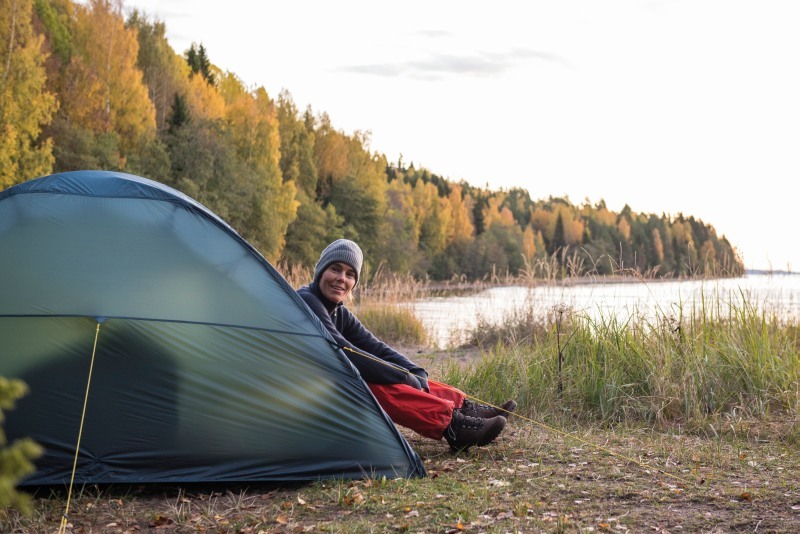
And that natural approach manages to permeate so much of Scandinavia's outdoor industry. Friluftsbyn itself is a new project envisioned by Fjallraven's former Marketing Director Jerry Engstrom, in an apparent bid to get back to what he loves. The Outdoor Village is a smattering of individual cabins spread around a wood-walled courtyard that resembles an Old-West fort, complete with a raised walkway around the ramparts.
But there's no marauding enemy, just a sublime view across a small lake to a quintessential Swedish church and an eternally setting autumn sun. There is no roof to separate us from the sky, and inside the walls are fire pits and dining tables, hanging lanterns and the odd lace-curtain-trim, to add a touch of hygge to the everyday elements.
Into the wild
But our cosy time at Friluftsbyn is short-lived, and loaded up with Helsport tents in Halti rucksacks, shod in Ecco hiking boots, insulated with Woolpower baselayers, and armed with fireknives from Light My Fire, we stride out into the Skuleskogen National Park. From a starting point near sea-level we enter the woods, and it appears the trees stretch on forever, the dominant feature of the landscape. But they are to reveal hidden secrets.
Soon we come to a lake. I wouldn't have expected water to be so breath-taking given the frequent glimpses of the sea en route, but the sight of still waters, bordered by foliage in every colour of the season is like an oasis in a coniferous desert. A well-maintained wooden shack painted red belies the fact we've passed nobody so far - this place may not be busy, but it is certainly not unused.
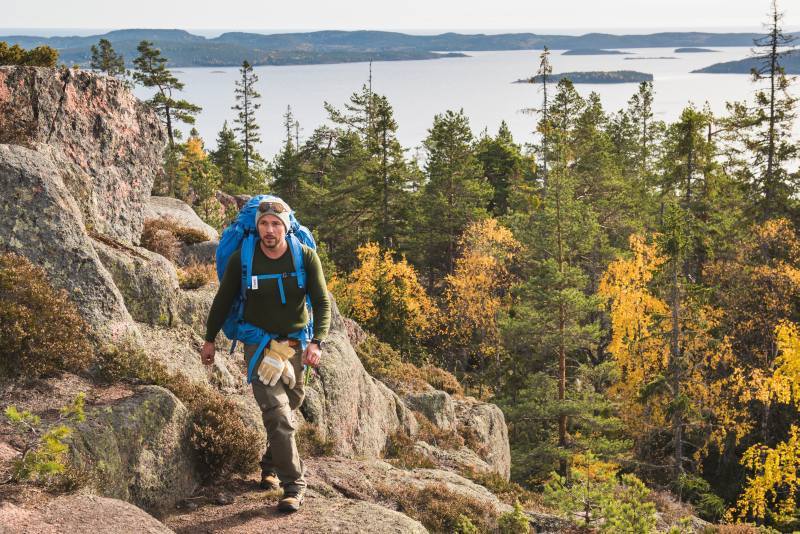
As we climb steadily, almost imperceptibly, higher, another major aspect of the landscape comes to the fore; bare rock. The park is far from mountainous - despite the fact the land is rising out of the sea faster than anywhere else on Earth - but it has dramatically bald summits and outcrops, sculpted from a jagged red granite, made all the more vibrant in colour by the low trajectory of the October sun.
Deeper into Skuleskogen its forms become more imposing, and our descent takes us to the edge of a deep and narrow gorge, previously hidden by the blanket of trees. An hour downhill and water dominates once again as we take our final steps to the campground along the sandy shore of the Baltic.
In the bright and golden light of a coastal morning we're about to get more closely acquainted with that water, courtesy of Melker Kayaks and a good deal of waterproof material.
The morning's destination is the uninhabited island of Mjalton, where we will land our boats and hike to the summit, before pitching tents on yet another perfectly secluded beach. The island is barely two kilometres away and looks close enough to touch over a gentle-looking channel.
The sun is warm on my face and the waterproof precautions seem almost unnecessary as I push off confidently into my first ever sea-kayak voyage. The first of the 3-inch breaking waves hits my kayak - which is inexplicably sideways to the incoming dwarf-waves - and I'm immediately grasping seabed and scrabbling to remain upright. The touch of water to skin gives a blinding insight into how the 'Baltic' turned from noun to adjective, and I physically stiffen in my resolve to avoid any further contact with it.
Those breaking ripples now appear like Big Wednesday to me, and my fear-based determination gets me past the oncoming set and into calmer water. I'm now about 10 metres from shore and still only knee high above the sea bed. But it's progress.
From my slightly more stable position (which I'm still working hard to maintain) I now have a chance to look around, and the shallow waters resemble a kayak-bound version of the opening scene of Saving Private Ryan. It seems I'm one of the lucky ones, and we all underestimated the power of a slow-moving, ankle-high crest of sea water.
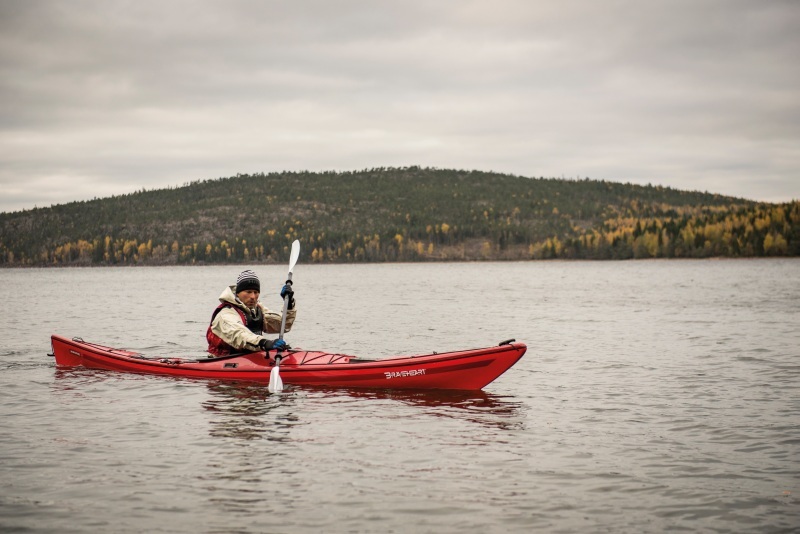
Eventually a degree of familiarity stabilises the group, and we stick relatively close to the shore as we paddle up our inlet towards the channel we need to cross. At the headland the waters become grey and mean looking, with peaks and troughs of almost a foot, but my capacity for bum-based balance has grown exponentially and against all the odds I get across the channel and into calmer waters without further close contact with the Baltic. It's a phenomenal experience to feel entirely vulnerable to the constant movement of something so synonymous with miserable cold, and to maintain composure for long enough to pass.
And the reward is glowing with warmth off my port side, reflecting that ubiquitous low-sun in a way the forbidding water couldn't; the deserted island of Mjalton.
Sea to summit
Maybe it's a renewed appreciation for terra firma, but hiking to the summit of Mjalton I'm engrossed in the details beneath my feet; auburn shrubs, fungi and a patchwork of lichen and moss in every conceivable shade of green and in patterns beyond the wit of any designer. And the regular plucking and eating of wild blueberries really reminds me of that constant connection to nature that exists in Sweden.
It's borne out once we reach the beach and the representative of Light My Fire talks us through several wild cooking recipes that result in a campsite feast that could not be further from the usual tepid baked beans.
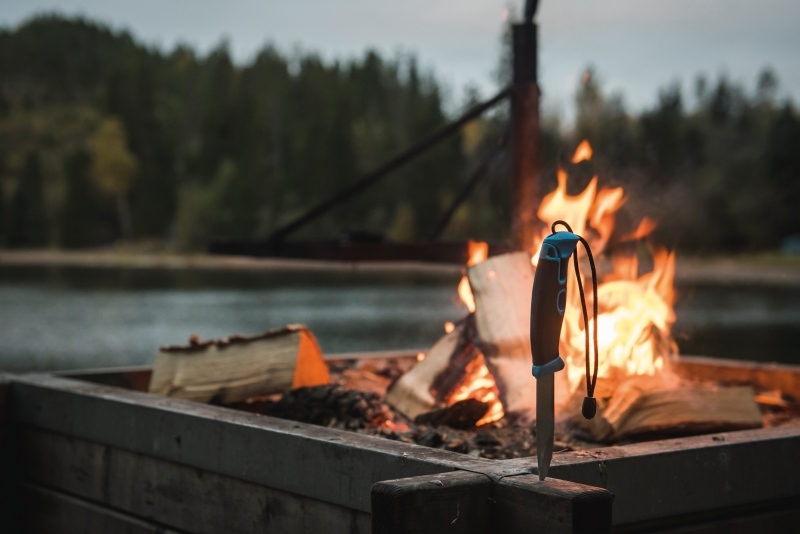
By the time morning comes I've realised that the Swedes don't do this as a weekend adventure; it's just a part of life. You can't be so comfortable outdoors without it being a home from home, and it feels like a new perspective that I'm incredibly grateful for. I'm ready for what I've come to view as today's Swedish triathlon; we're hiking back to the kayaks, paddling back over to the mainland, and climbing the via ferrata at Skuleberget.
The walk passes by with serenity, and the aforementioned lichen covered floor radiates a kind of mystical haze. Our fingers become further blueberry-stained. Even the paddling seems second-nature today, and we pass an admittedly shorter route without incident. And finally we come to the crag at Skuleberget.
It's not an imposing Alpine big wall, and as a veteran of many Dolomiti via feratta, I don't expect much. But I'm wrong. The 'Red' route (the hardest option - black - has been closed for repairs) is packed with varied climbing, thuggish moves and airy traverses. Best of all though, the elevated position acts as a summary of everything that has gone before; the islands are cleared separated from the mainland, the scattered clouds are almost with reach and the whole is covered in a patchwork of rusty hues, lit from an oblique angle by the sub-arctic sun.
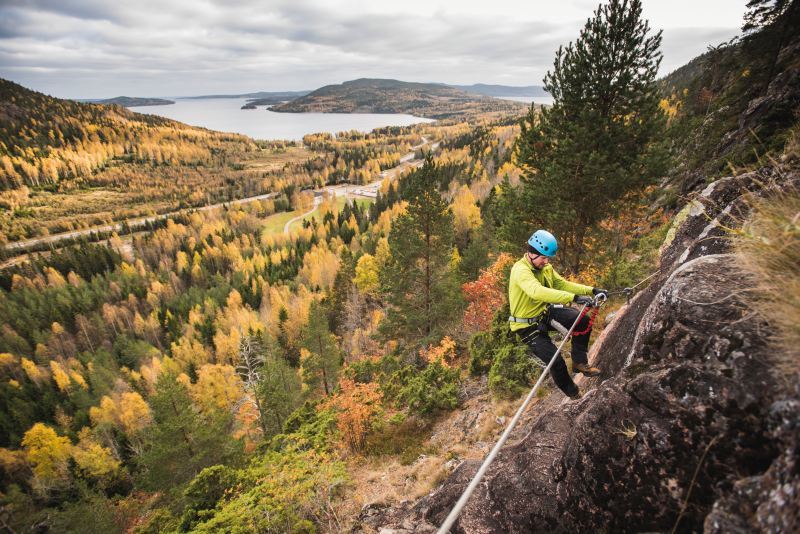
It's a spectacular finish, and it turns out Friluftsbyn is just down the other side of the crag we've climbed. We watch the sun sink even further from the summit of Skuleberget, which to my surprise has a ski lift serving the locals during winter.
And that sums everything up for me. A one-lift ski hill and a tiny National Park would not be considered profitable in many countries. I'm sure the tourist board would welcome an increase in overseas visitors, but the underlying feeling is that this wilderness will be maintained and protected no matter what; it's everyone's back yard, and the locals don't just visit it - they live it.
Daniel's trip
What to pack For autumn adventures, pack similar clothing and camping gear as you would in the UK with perhaps an extra layer for evenings.
Getting there Daniel flew from Manchester to Stockholm with SAS flysas.com and to Ornskoldsvik with Hoga Kusten Flyg hogakustenflyg.se
Getting around Once at Friluftsbyn, transportation was predominantly human-powered. However Friluftsbyn can arrange transportation to any of the activities.
Food and drink In keeping with how the place is run, the food at Friluftsbyn and on the trail was produced with a huge respect for local farmers and produce. Venison and beef from within a 30 mile radius, and ice cream flavoured with pine were particular highlights. Also, try the Hoga Kusten craft beer.
Where to stay As a stepping stone between civilisation and the wild, and a base for all kinds of adventures, Friluftsbyn cannot be beaten. But to make the most of the area, bring a tent! friluftsbyn.se

